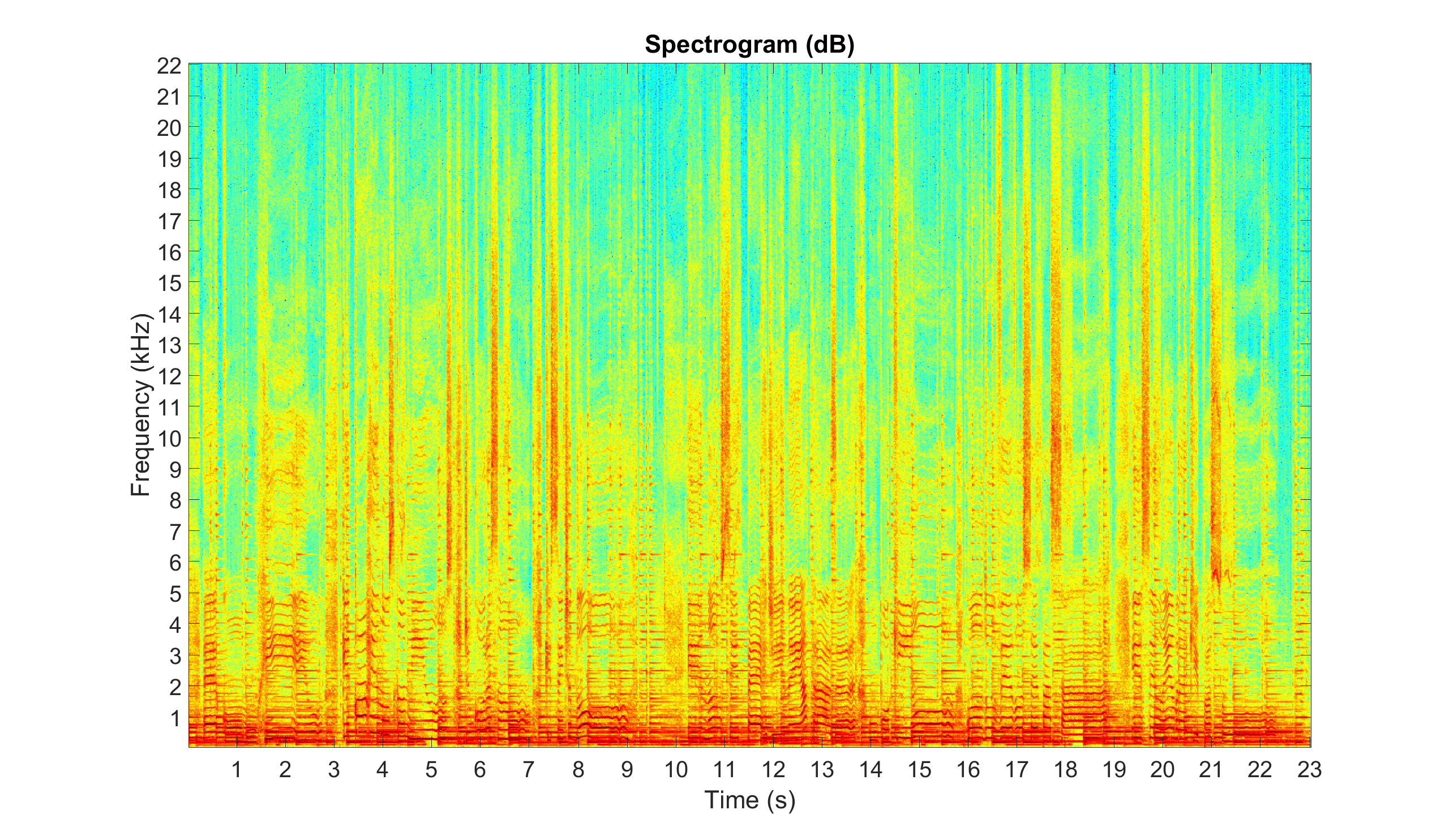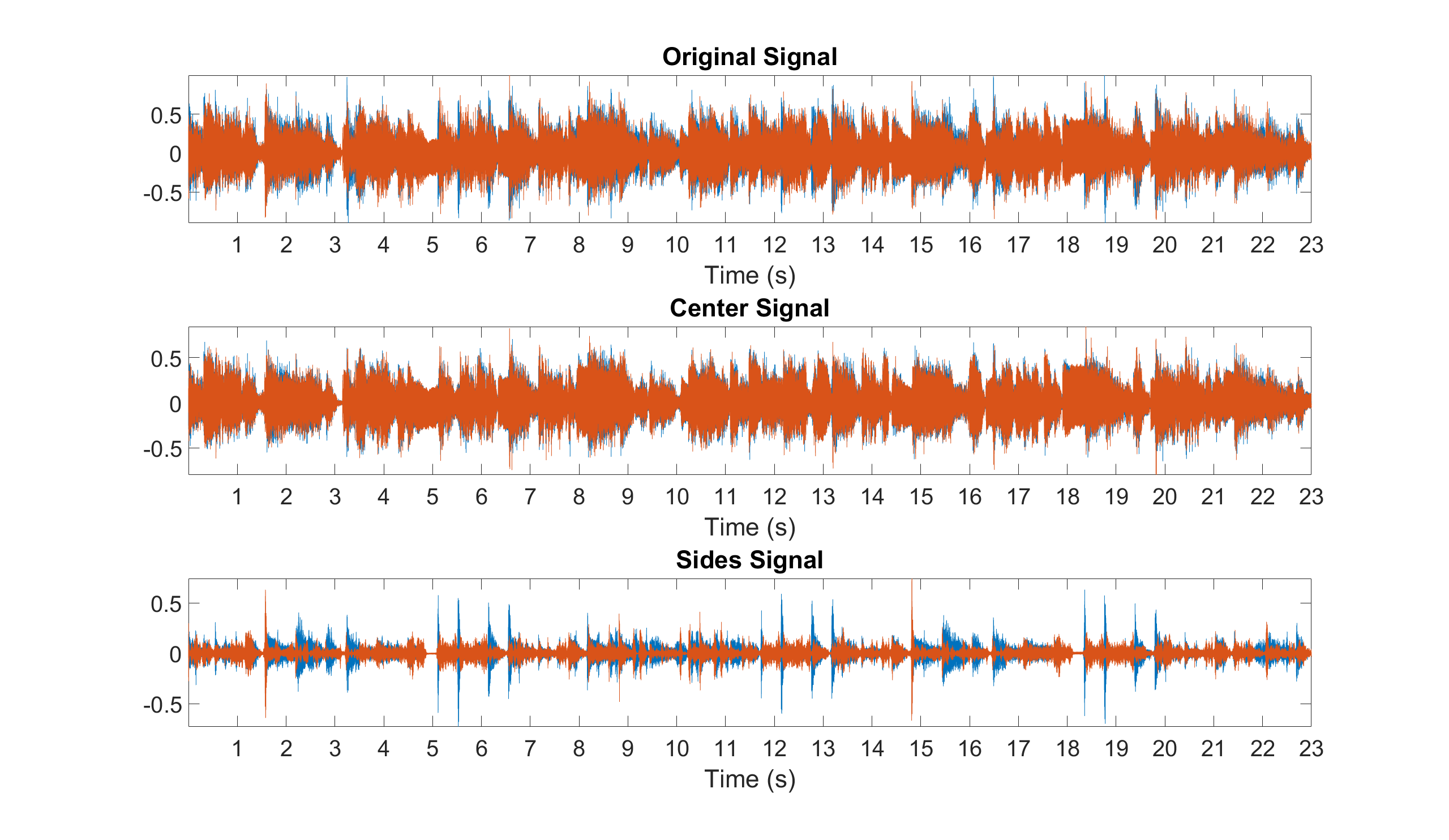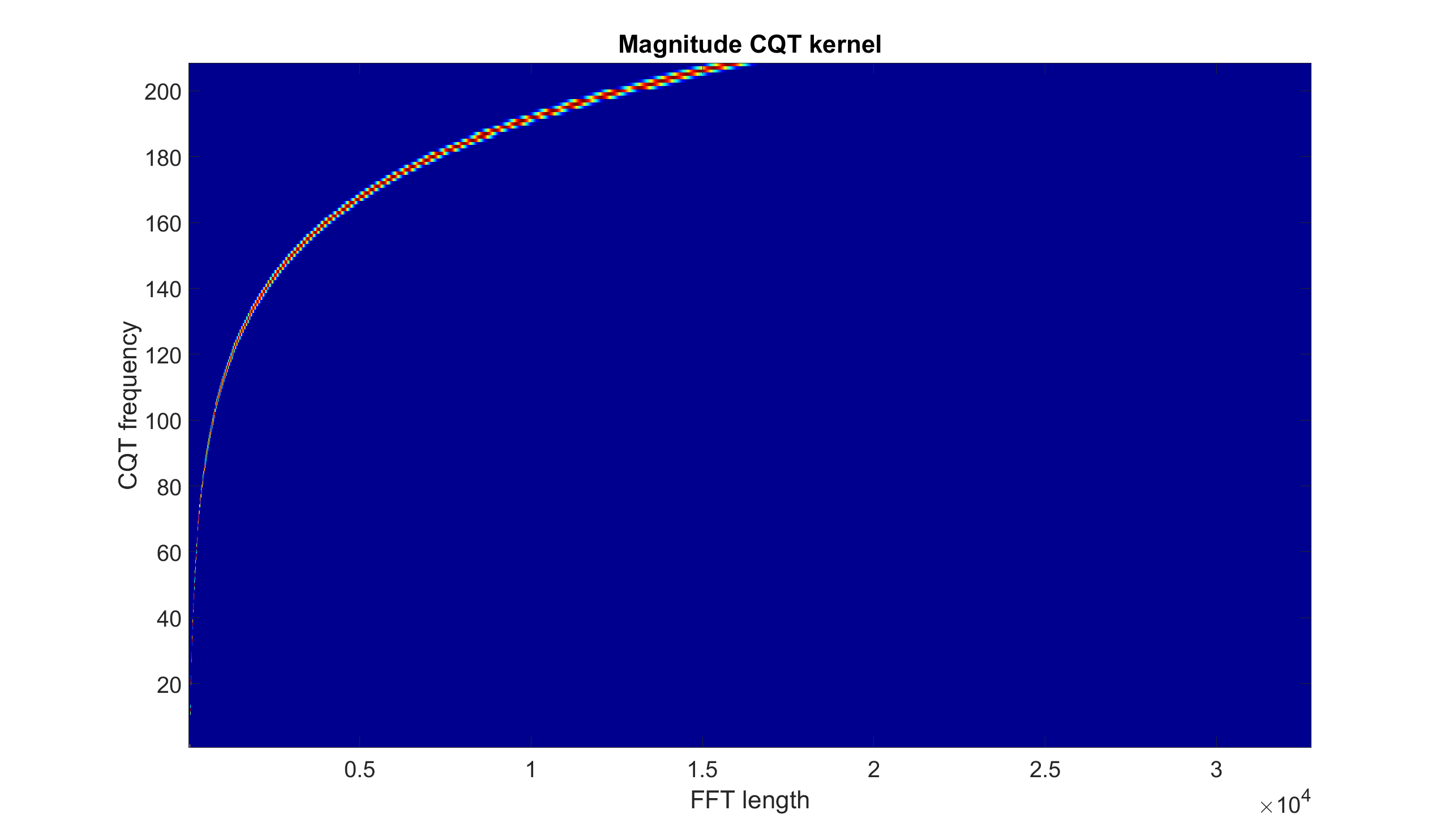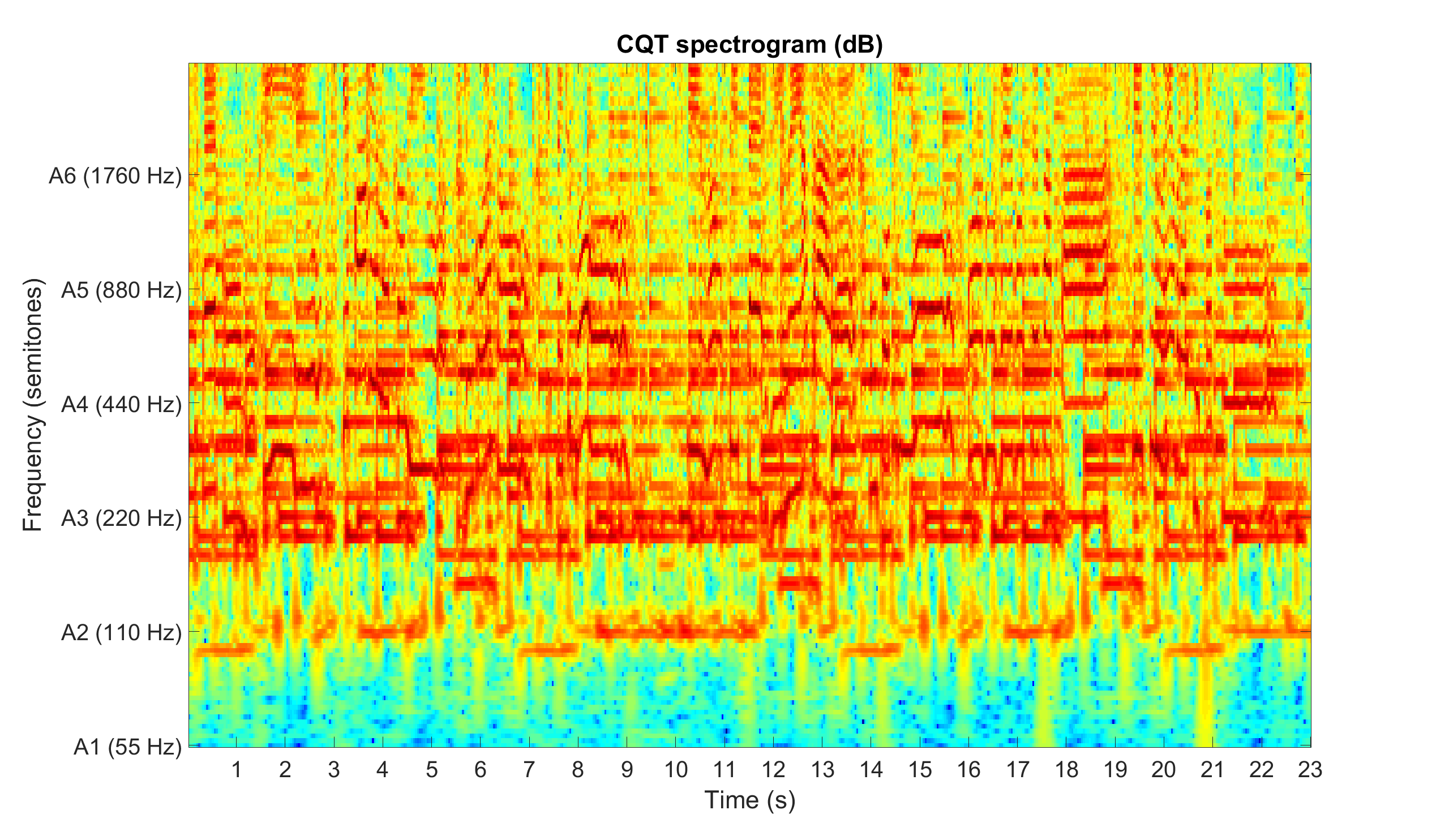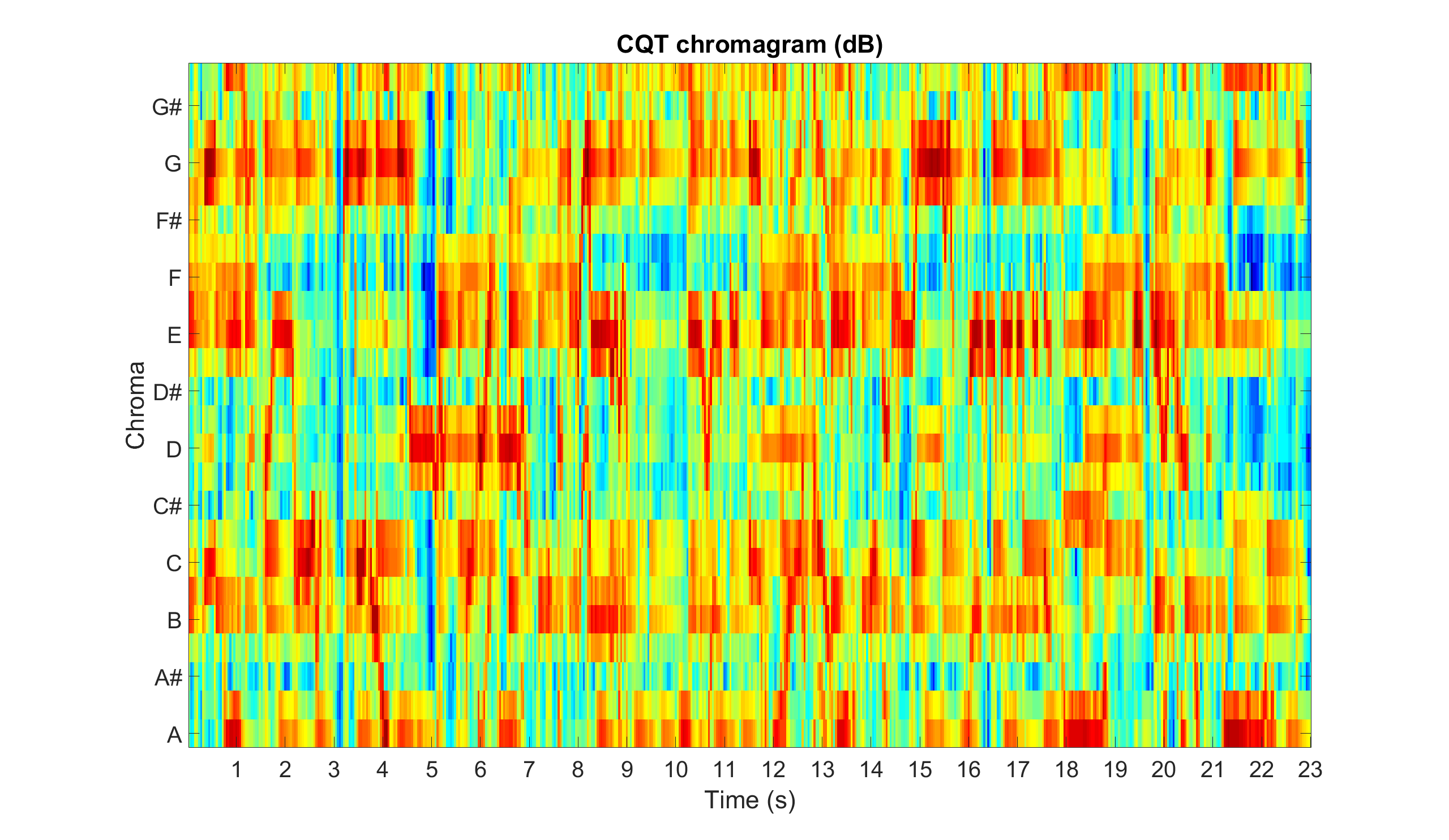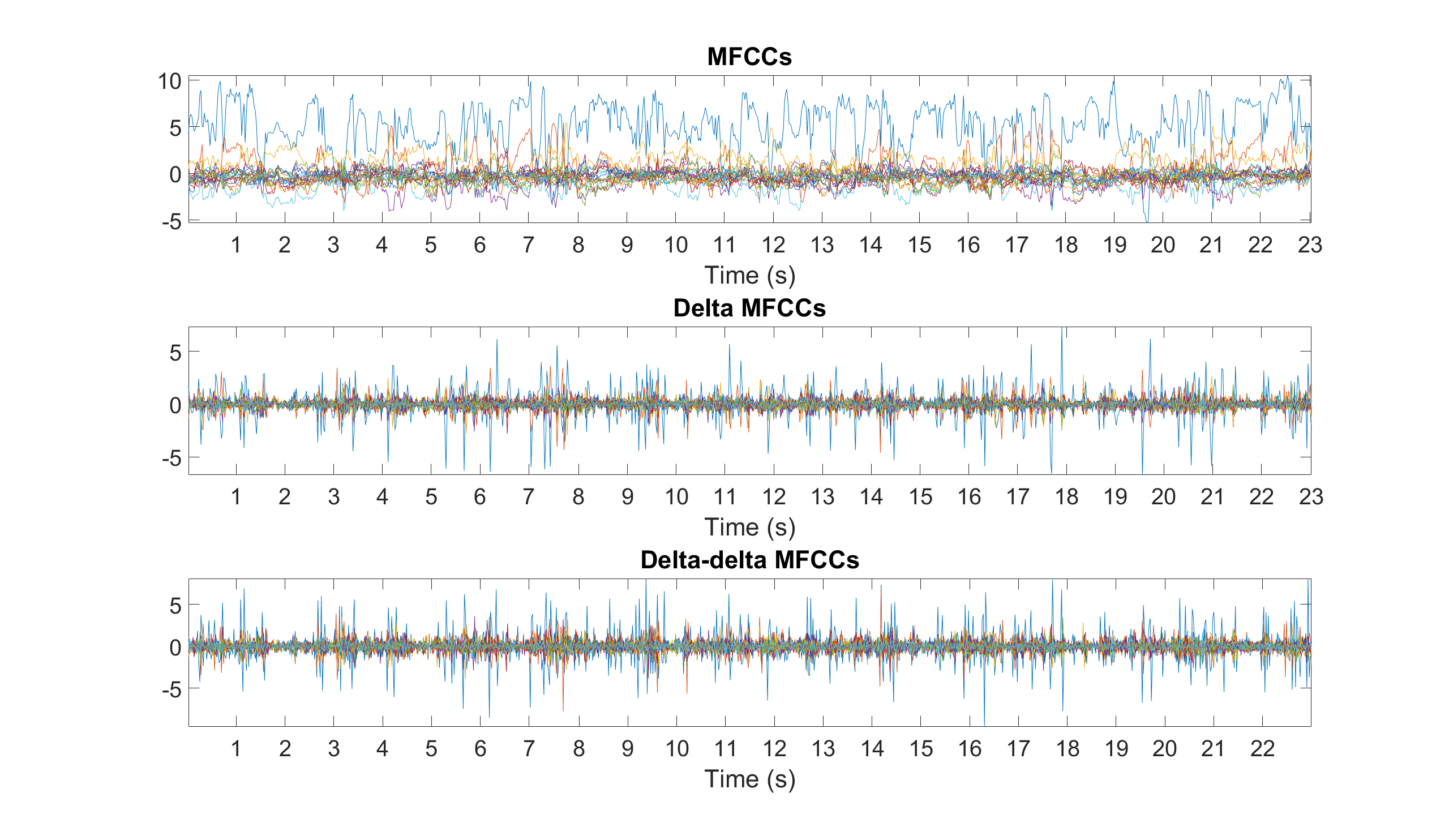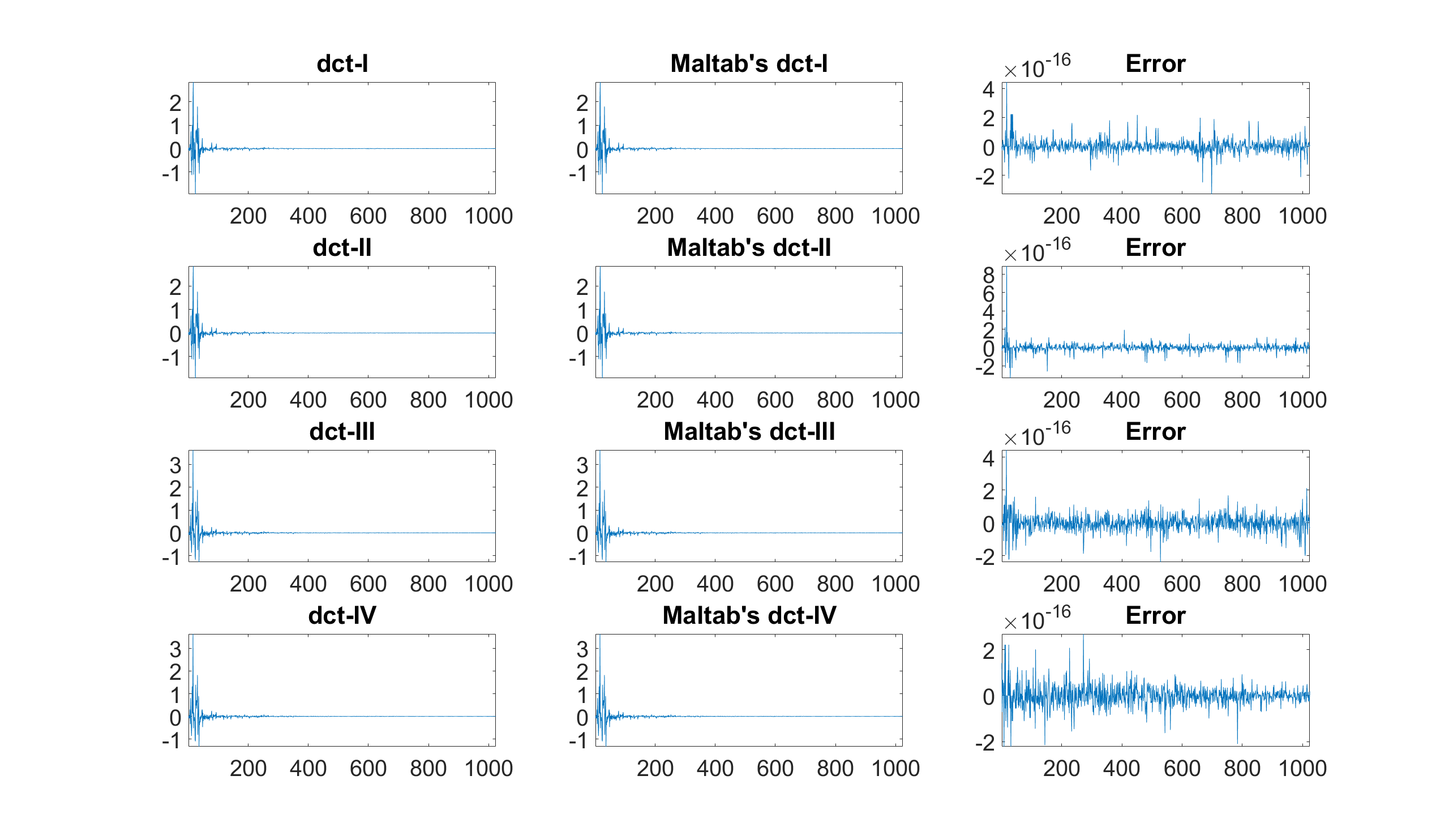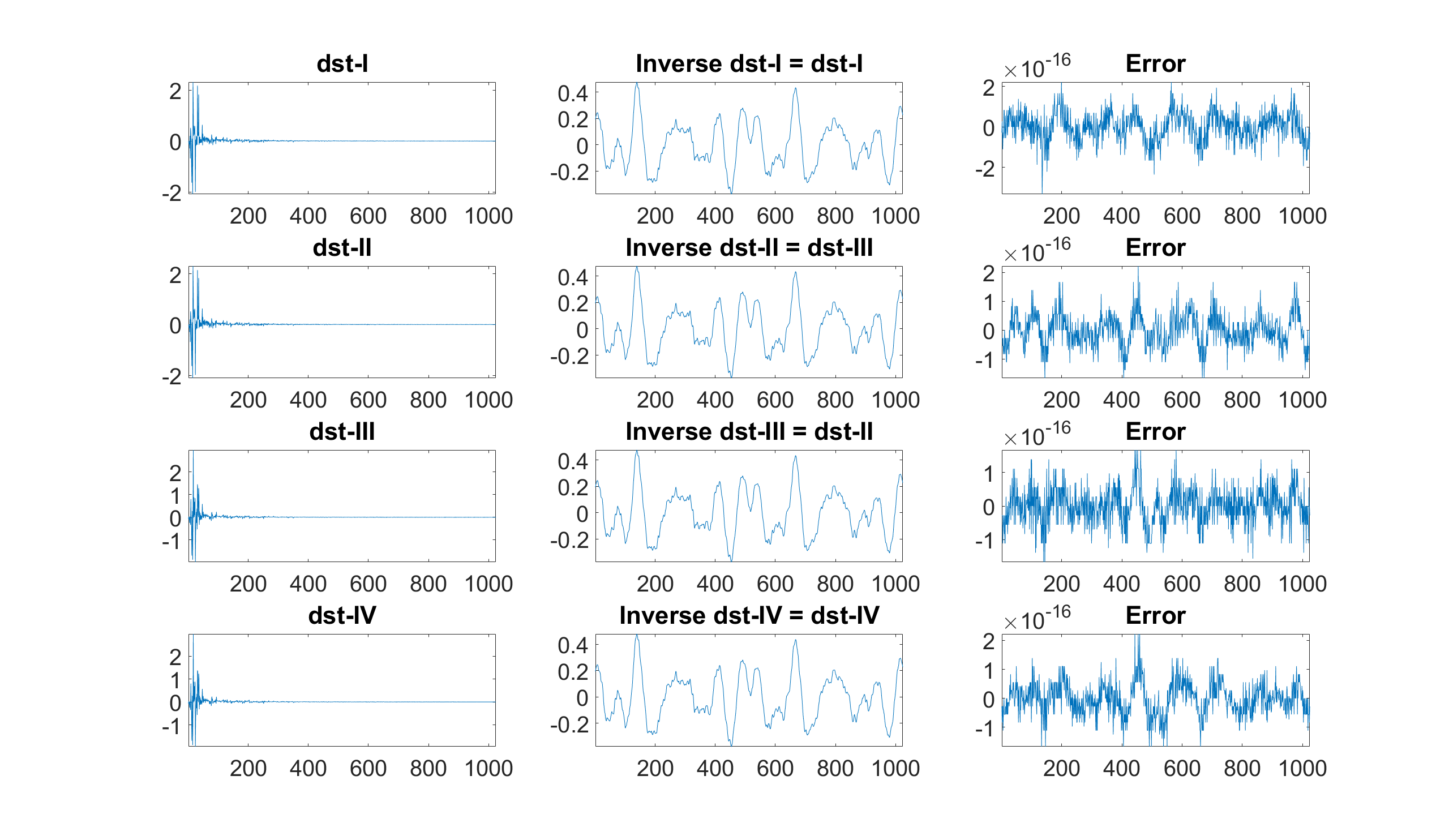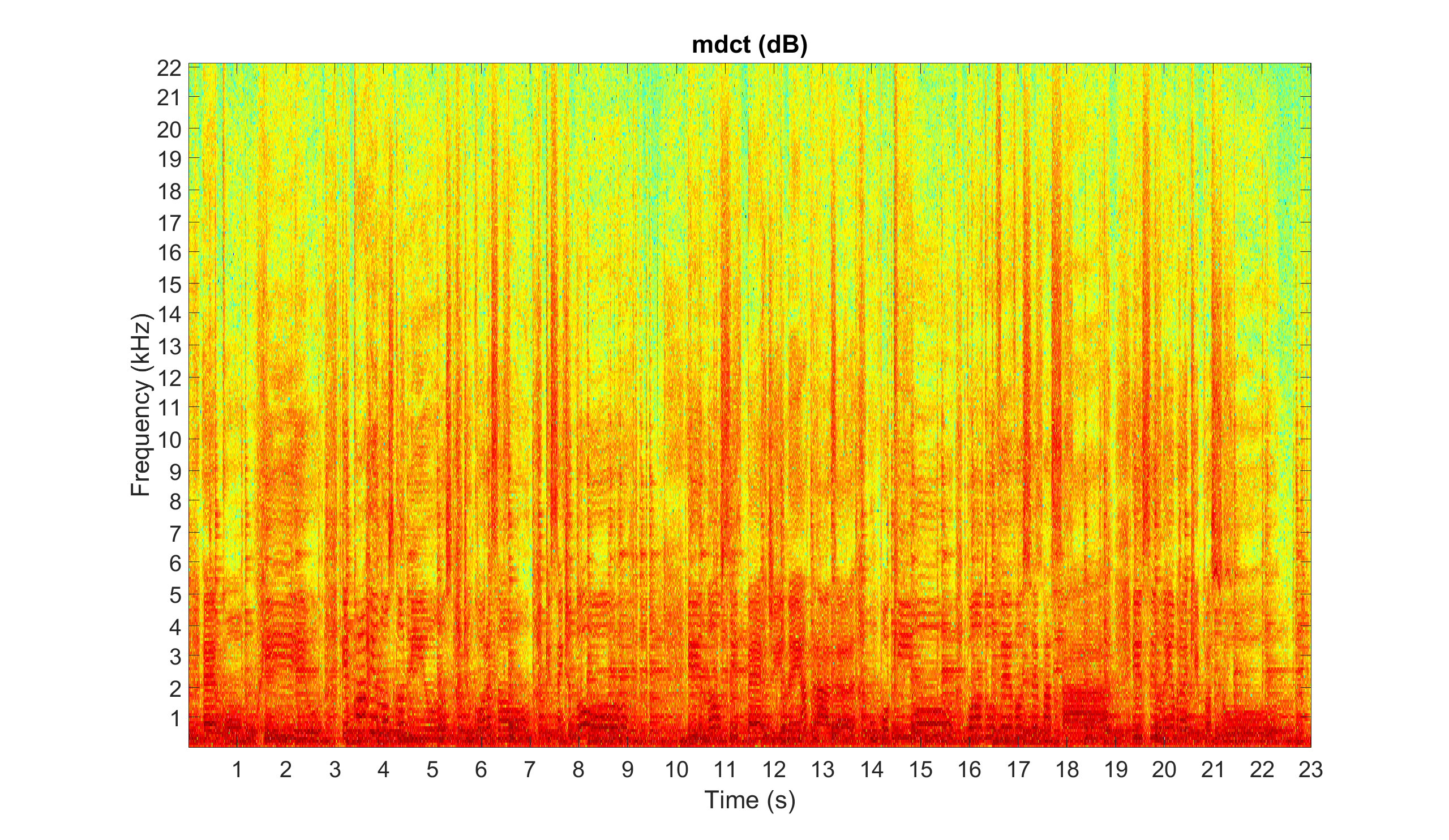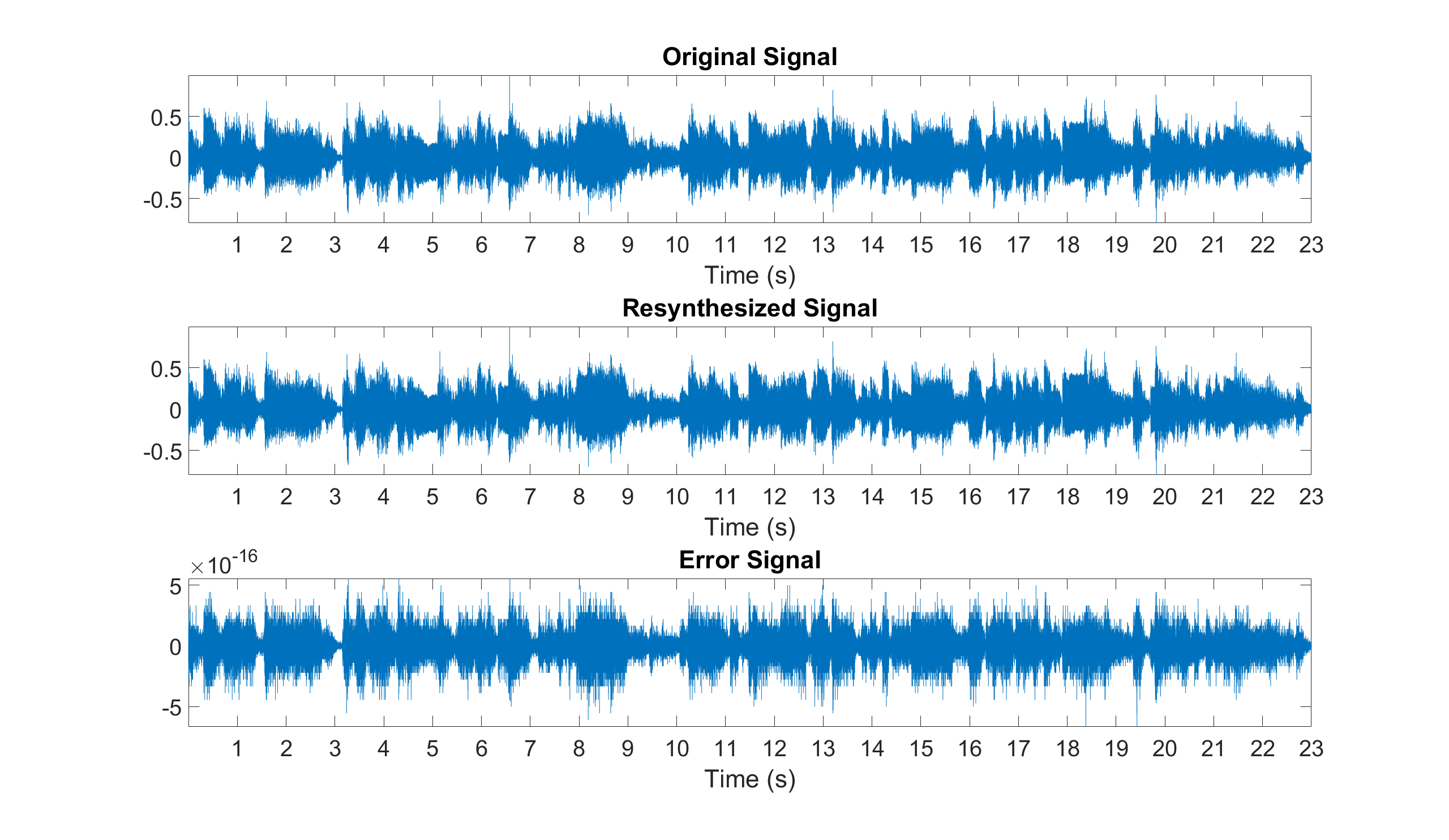Z
This repository includes a Matlab class and a Julia module which implement/illustrate several methods/functions for audio signal processing. For the updated Python module, see: https://github.com/zafarrafii/Zaf-Python
z Matlab class
z This class implements several methods for audio signal processing.
z Methods:
- stft - Short-time Fourier transform (STFT)
- istft - Inverse STFT
- cqtkernel - Constant-Q transform (CQT) kernel
- cqtspectrogram - CQT spectrogram using a CQT kernel
- cqtchromagram - CQT chromagram using a CQT kernel
- mfcc - Mel frequency cepstrum coefficients (MFCCs)
- dct - Discrete cosine transform (DCT) using the fast Fourier transform (FFT)
- dst - Discrete sine transform (DST) using the FFT
- mdct - Modified discrete cosine transform (MDCT) using the DCT-IV
- imdct - Inverse MDCT using the DCT-IV
stft Short-time Fourier transform (STFT)
audio_stft = z.stft(audio_signal,window_function,step_length);
Arguments:
audio_signal: audio signal [number_samples,1]
window_function: window function [window_length,1]
step_length: step length in samples
audio_stft: audio stft [window_length,number_frames]
Example: Compute and display the spectrogram of an audio file
% Audio signal averaged over its channels and sample rate in Hz
[audio_signal,sample_rate] = audioread('audio_file.wav');
audio_signal = mean(audio_signal,2);
% Window duration in seconds (audio is stationary around 40 milliseconds)
window_duration = 0.04;
% Window length in samples (power of 2 for fast FFT and constant overlap-add (COLA))
window_length = 2^nextpow2(window_duration*sample_rate);
% Window function (periodic Hamming window for COLA)
window_function = hamming(window_length,'periodic');
% Step length in samples (half the window length for COLA)
step_length = window_length/2;
% Magnitude spectrogram (without the DC component and the mirrored frequencies)
audio_stft = z.stft(audio_signal,window_function,step_length);
audio_spectrogram = abs(audio_stft(2:window_length/2+1,:));
% Spectrogram displayed in dB, s, and kHz
figure
imagesc(db(audio_spectrogram))
axis xy
colormap(jet)
title('Spectrogram (dB)')
xticks(round((1:floor(length(audio_signal)/sample_rate))*sample_rate/step_length))
xticklabels(1:floor(length(audio_signal)/sample_rate))
xlabel('Time (s)')
yticks(round((1e3:1e3:sample_rate/2)/sample_rate*window_length))
yticklabels(1:sample_rate/2*1e-3)
ylabel('Frequency (kHz)')
set(gca,'FontSize',30)
istft Inverse short-time Fourier transform (STFT)
audio_signal = z.istft(audio_stft,window_function,step_length);
Arguments:
audio_stft: audio STFT [window_length,number_frames]
window_function: window function [window_length,1]
step_length: step length in samples
audio_signal: audio signal [number_samples,1]
Example: Estimate the center and sides signals of a stereo audio file
% Stereo signal and sample rate in Hz
[audio_signal,sample_rate] = audioread('audio_file.wav');
% Parameters for the STFT
window_duration = 0.04;
window_length = 2^nextpow2(window_duration*sample_rate);
window_function = hamming(window_length,'periodic');
step_length = window_length/2;
% STFT of the left and right channels
audio_stft1 = z.stft(audio_signal(:,1),window_function,step_length);
audio_stft2 = z.stft(audio_signal(:,2),window_function,step_length);
% Magnitude spectrogram (with DC component) of the left and right channels
audio_spectrogram1 = abs(audio_stft1(1:window_length/2+1,:));
audio_spectrogram2 = abs(audio_stft2(1:window_length/2+1,:));
% Time-frequency mask of the left and right channels of the center signal
center_mask1 = min(audio_spectrogram1,audio_spectrogram2)./audio_spectrogram1;
center_mask2 = min(audio_spectrogram1,audio_spectrogram2)./audio_spectrogram2;
% STFT of the left and right channels of the center signal (with extension to mirrored frequencies)
center_stft1 = [center_mask1;center_mask1(window_length/2:-1:2,:)].*audio_stft1;
center_stft2 = [center_mask2;center_mask2(window_length/2:-1:2,:)].*audio_stft2;
% Synthesized signals of the left and right channels of the center signal
center_signal1 = z.istft(center_stft1,window_function,step_length);
center_signal2 = z.istft(center_stft2,window_function,step_length);
% Finalized stereo center and sides signals
center_signal = [center_signal1,center_signal2];
center_signal = center_signal(1:length(audio_signal),:);
sides_signal = audio_signal-center_signal;
% Synthesized center and side signals
audiowrite('center_signal.wav',center_signal,sample_rate);
audiowrite('sides_signal.wav',sides_signal,sample_rate);
% Original, center, and sides signals displayed in s
figure
subplot(3,1,1), plot(audio_signal), axis tight, title('Original Signal')
xticks(sample_rate:sample_rate:length(audio_signal))
xticklabels(1:floor(length(audio_signal)/sample_rate))
xlabel('Time (s)'), set(gca,'FontSize',30)
subplot(3,1,2), plot(center_signal), axis tight, title('Center Signal')
xticks(sample_rate:sample_rate:length(audio_signal))
xticklabels(1:floor(length(audio_signal)/sample_rate))
xlabel('Time (s)'), set(gca,'FontSize',30)
subplot(3,1,3), plot(sides_signal), axis tight, title('Sides Signal')
xticks(sample_rate:sample_rate:length(audio_signal))
xticklabels(1:floor(length(audio_signal)/sample_rate))
xlabel('Time (s)'), set(gca,'FontSize',30)
cqtkernel Constant-Q transform (CQT) kernel
cqt_kernel = z.cqtkernel(sample_rate,frequency_resolution,minimum_frequency,maximum_frequency);
Arguments:
sample_rate: sample rate in Hz
frequency_resolution: frequency resolution in number of frequency channels per semitone
minimum_frequency: minimum frequency in Hz
maximum_frequency: maximum frequency in Hz
cqt_kernel: CQT kernel [number_frequencies,fft_length]
Example: Compute and display the CQT kernel
% CQT kernel parameters
sample_rate = 44100;
frequency_resolution = 2;
minimum_frequency = 55;
maximum_frequency = sample_rate/2;
% CQT kernel
cqt_kernel = z.cqtkernel(sample_rate,frequency_resolution,minimum_frequency,maximum_frequency);
% Magnitude CQT kernel displayed
figure
imagesc(abs(cqt_kernel))
axis xy
colormap(jet)
title('Magnitude CQT kernel')
xlabel('FFT length')
ylabel('CQT frequency')
set(gca,'FontSize',30)
cqtspectrogram Constant-Q transform (CQT) spectrogram using a CQT kernel
audio_spectrogram = z.cqtspectrogram(audio_signal,sample_rate,time_resolution,cqt_kernel);
Arguments:
audio_signal: audio signal [number_samples,1]
sample_rate: sample rate in Hz
time_resolution: time resolution in number of time frames per second
cqt_kernel: CQT kernel [number_frequencies,fft_length]
audio_spectrogram: audio spectrogram in magnitude [number_frequencies,number_times]
Example: Compute and display the CQT spectrogram
% Audio file averaged over the channels and sample rate in Hz
[audio_signal,sample_rate] = audioread('audio_file.wav');
audio_signal = mean(audio_signal,2);
% CQT kernel
frequency_resolution = 2;
minimum_frequency = 55;
maximum_frequency = 3520;
cqt_kernel = z.cqtkernel(sample_rate,frequency_resolution,minimum_frequency,maximum_frequency);
% CQT spectrogram
time_resolution = 25;
audio_spectrogram = z.cqtspectrogram(audio_signal,sample_rate,time_resolution,cqt_kernel);
% CQT spectrogram displayed in dB, s, and semitones
figure
imagesc(db(audio_spectrogram))
axis xy
colormap(jet)
title('CQT spectrogram (dB)')
xticks(round((1:floor(length(audio_signal)/sample_rate))*time_resolution))
xticklabels(1:floor(length(audio_signal)/sample_rate))
xlabel('Time (s)')
yticks(1:12*frequency_resolution:6*12*frequency_resolution)
yticklabels({'A1 (55 Hz)','A2 (110 Hz)','A3 (220 Hz)','A4 (440 Hz)','A5 (880 Hz)','A6 (1760 Hz)'})
ylabel('Frequency (semitones)')
set(gca,'FontSize',30)
cqtchromagram Constant-Q transform (CQT) chromagram using a CQT kernel
audio_chromagram = z.cqtchromagram(audio_signal,sample_rate,time_resolution,frequency_resolution,cqt_kernel);
Arguments:
audio_signal: audio signal [number_samples,1]
sample_rate: sample rate in Hz
time_resolution: time resolution in number of time frames per second
frequency_resolution: frequency resolution in number of frequency channels per semitones
cqt_kernel: CQT kernel [number_frequencies,fft_length]
audio_chromagram: audio chromagram [number_chromas,number_times]
Example: Compute and display the CQT chromagram
% Audio file averaged over the channels and sample rate in Hz
[audio_signal,sample_rate] = audioread('audio_file.wav');
audio_signal = mean(audio_signal,2);
% CQT kernel
frequency_resolution = 2;
minimum_frequency = 55;
maximum_frequency = 3520;
cqt_kernel = z.cqtkernel(sample_rate,frequency_resolution,minimum_frequency,maximum_frequency);
% CQT chromagram
time_resolution = 25;
audio_chromagram = z.cqtchromagram(audio_signal,sample_rate,time_resolution,frequency_resolution,cqt_kernel);
% CQT chromagram displayed in dB, s, and chromas
figure
imagesc(db(audio_chromagram))
axis xy
colormap(jet)
title('CQT chromagram (dB)')
xticks(round((1:floor(length(audio_signal)/sample_rate))*time_resolution))
xticklabels(1:floor(length(audio_signal)/sample_rate))
xlabel('Time (s)')
yticks(1:frequency_resolution:12*frequency_resolution)
yticklabels({'A','A#','B','C','C#','D','D#','E','F','F#','G','G#'})
ylabel('Chroma')
set(gca,'FontSize',30)
mfcc Mel frequency cepstrum coefficients (MFCCs)
audio_mfcc = z.mfcc(audio_signal,sample_rate,number_filters,number_coefficients);
Arguments:
audio_signal: audio signal [number_samples,1]
sample_rate: sample rate in Hz
number_filters: number of filters
number_coefficients: number of coefficients (without the 0th coefficient)
audio_mfcc: audio MFCCs [number_times,number_coefficients]
Example: Compute and display the MFCCs, delta MFCCs, and delta-detla MFCCs
% Audio signal averaged over its channels and sample rate in Hz
[audio_signal,sample_rate] = audioread('audio_file.wav');
audio_signal = mean(audio_signal,2);
% MFCCs for a given number of filters and coefficients
number_filters = 40;
number_coefficients = 20;
audio_mfcc = z.mfcc(audio_signal,sample_rate,number_filters,number_coefficients);
% Delta and delta-delta MFCCs
audio_deltamfcc = diff(audio_mfcc,1,2);
audio_deltadeltamfcc = diff(audio_deltamfcc,1,2);
% MFCCs, delta MFCCs, and delta-delta MFCCs displayed in s
step_length = (2^nextpow2(0.04*sample_rate))/2;
figure
subplot(3,1,1), plot(audio_mfcc'), axis tight, title('MFCCs')
xticks(round((1:floor(length(audio_signal)/sample_rate))*sample_rate/step_length))
xticklabels(1:floor(length(audio_signal)/sample_rate))
xlabel('Time (s)'), set(gca,'FontSize',30)
subplot(3,1,2), plot(audio_deltamfcc'), axis tight, title('Delta MFCCs')
xticks(round((1:floor(length(audio_signal)/sample_rate))*sample_rate/step_length))
xticklabels(1:floor(length(audio_signal)/sample_rate))
xlabel('Time (s)'), set(gca,'FontSize',30)
subplot(3,1,3), plot(audio_deltadeltamfcc'), axis tight, title('Delta-delta MFCCs')
xticks(round((1:floor(length(audio_signal)/sample_rate))*sample_rate/step_length))
xticklabels(1:floor(length(audio_signal)/sample_rate))
xlabel('Time (s)'), set(gca,'FontSize',30)
dct Discrete cosine transform (DCT) using the fast Fourier transform (FFT)
audio_dct = z.dct(audio_signal,dct_type);
Arguments:
audio_signal: audio signal [number_samples,number_frames]
dct_type: dct type (1, 2, 3, or 4)
audio_dct: audio DCT [number_frequencies,number_frames]
Example: Compute the 4 different DCTs and compare them to Matlab's DCTs
% Audio signal averaged over its channels and sample rate in Hz
[audio_signal,sample_rate] = audioread('audio_file.wav');
audio_signal = mean(audio_signal,2);
% Audio signal for a given window length, and one frame
window_length = 1024;
audio_signal = audio_signal(1:window_length);
% DCT-I, II, III, and IV
audio_dct1 = z.dct(audio_signal,1);
audio_dct2 = z.dct(audio_signal,2);
audio_dct3 = z.dct(audio_signal,3);
audio_dct4 = z.dct(audio_signal,4);
% Matlab's DCT-I, II, III, and IV
matlab_dct1 = dct(audio_signal,'Type',1);
matlab_dct2 = dct(audio_signal,'Type',2);
matlab_dct3 = dct(audio_signal,'Type',3);
matlab_dct4 = dct(audio_signal,'Type',4);
% DCT-I, II, III, and IV, Matlab's versions, and errors displayed
figure
subplot(4,3,1), plot(audio_dct1), axis tight, title('DCT-I'), set(gca,'FontSize',30)
subplot(4,3,2), plot(matlab_dct1), axis tight, title('Maltab''s DCT-I'), set(gca,'FontSize',30)
subplot(4,3,3), plot(audio_dct1-matlab_dct1), axis tight, title('Error'), set(gca,'FontSize',30)
subplot(4,3,4), plot(audio_dct2), axis tight, title('DCT-II'), set(gca,'FontSize',30)
subplot(4,3,5), plot(matlab_dct2),axis tight, title('Maltab''s DCT-II'), set(gca,'FontSize',30)
subplot(4,3,6), plot(audio_dct2-matlab_dct2), axis tight, title('Error'), set(gca,'FontSize',30)
subplot(4,3,7), plot(audio_dct3), axis tight, title('DCT-III'), set(gca,'FontSize',30)
subplot(4,3,8), plot(matlab_dct3), axis tight, title('Maltab''s DCT-III'), set(gca,'FontSize',30)
subplot(4,3,9), plot(audio_dct3-matlab_dct3), axis tight, title('Error'), set(gca,'FontSize',30)
subplot(4,3,10), plot(audio_dct4), axis tight, title('DCT-IV'), set(gca,'FontSize',30)
subplot(4,3,11), plot(matlab_dct4), axis tight, title('Maltab''s DCT-IV'), set(gca,'FontSize',30)
subplot(4,3,12), plot(audio_dct4-matlab_dct4), axis tight, title('Error'), set(gca,'FontSize',30)
dst Discrete sine transform (DST) using the fast Fourier transform (FFT)
audio_dst = z.dst(audio_signal,dst_type);
Arguments:
audio_signal: audio signal [number_samples,number_frames]
dst_type: DST type (1, 2, 3, or 4)
audio_dst: audio DST [number_frequencies,number_frames]
Example: Compute the 4 different DSTs and compare them to their respective inverses
% Audio signal averaged over its channels and sample rate in Hz
[audio_signal,sample_rate] = audioread('audio_file.wav');
audio_signal = mean(audio_signal,2);
% Audio signal for a given window length, and one frame
window_length = 1024;
audio_signal = audio_signal(1:window_length);
% DST-I, II, III, and IV
audio_dst1 = z.dst(audio_signal,1);
audio_dst2 = z.dst(audio_signal,2);
audio_dst3 = z.dst(audio_signal,3);
audio_dst4 = z.dst(audio_signal,4);
% Respective inverses, i.e., DST-I, III, II, and IV
audio_idst1 = z.dst(audio_dst1,1);
audio_idst2 = z.dst(audio_dst2,3);
audio_idst3 = z.dst(audio_dst3,2);
audio_idst4 = z.dst(audio_dst4,4);
% DST-I, II, III, and IV, respective inverses, and errors displayed
figure
subplot(4,3,1), plot(audio_dst1), axis tight, title('DST-I'), set(gca,'FontSize',30)
subplot(4,3,2), plot(audio_idst1), axis tight, title('Inverse DST-I = DST-I'), set(gca,'FontSize',30)
subplot(4,3,3), plot(audio_signal-audio_idst1), axis tight, title('Error'), set(gca,'FontSize',30)
subplot(4,3,4), plot(audio_dst2), axis tight, title('DST-II'), set(gca,'FontSize',30)
subplot(4,3,5), plot(audio_idst2), axis tight, title('Inverse DST-II = DST-III'), set(gca,'FontSize',30)
subplot(4,3,6), plot(audio_signal-audio_idst2), axis tight, title('Error'), set(gca,'FontSize',30)
subplot(4,3,7), plot(audio_dst3), axis tight, title('DST-III'), set(gca,'FontSize',30)
subplot(4,3,8), plot(audio_idst3), axis tight, title('Inverse DST-III = DST-II'), set(gca,'FontSize',30)
subplot(4,3,9), plot(audio_signal-audio_idst3), axis tight, title('Error'), set(gca,'FontSize',30)
subplot(4,3,10), plot(audio_dst4), axis tight, title('DST-IV'), set(gca,'FontSize',30)
subplot(4,3,11), plot(audio_idst4), axis tight, title('Inverse DST-IV = DST-IV'), set(gca,'FontSize',30)
subplot(4,3,12), plot(audio_signal-audio_idst4, axis tight, title('Error'), set(gca,'FontSize',30)
mdct Modified discrete cosine transform (MDCT) using the DCT-IV
audio_mdct = z.mdct(audio_signal,window_function);
Arguments:
audio_signal: audio signal [number_samples,1]
window_function: window function [window_length,1]
audio_mdct: audio MDCT [number_frequencies,number_times]
Example: Compute and display the MDCT as used in the AC-3 audio coding format
% Audio file averaged over the channels and sample rate in Hz
[audio_signal,sample_rate] = audioread('audio_file.wav');
audio_signal = mean(audio_signal,2);
% Kaiser-Bessel-derived (KBD) window as used in the AC-3 audio coding format
window_length = 2048;
alpha_value = 5;
window_function = kaiser(window_length/2+1,alpha_value*pi);
window_function2 = cumsum(window_function(1:window_length/2));
window_function = sqrt([window_function2;window_function2(window_length/2:-1:1)]./sum(window_function));
% MDCT
audio_mdct = z.mdct(audio_signal,window_function);
% MDCT displayed in dB, s, and kHz
figure
imagesc(db(audio_mdct))
axis xy
colormap(jet)
title('mdct (dB)')
xticks(round((1:floor(length(audio_signal)/sample_rate))*sample_rate/(window_length/2)))
xticklabels(1:floor(length(audio_signal)/sample_rate))
xlabel('Time (s)')
yticks(round((1e3:1e3:sample_rate/2)/sample_rate*window_length))
yticklabels(1:sample_rate/2*1e-3)
ylabel('Frequency (kHz)')
set(gca,'FontSize',30)
imdct Inverse modified discrete cosine transform (MDCT) using the DCT-IV
audio_signal = z.imdct(audio_mdct,window_function);
Arguments:
window_function: window function [window_length,1]
audio_mdct: audio MDCT [number_frequencies,number_times]
audio_signal: audio signal [number_samples,1]
Example: Verify that the MDCT is perfectly invertible
% Audio file averaged over the channels and sample rate in Hz
[audio_signal,sample_rate] = audioread('audio_file.wav');
audio_signal = mean(audio_signal,2);
% MDCT with a slope function as used in the Vorbis audio coding format
window_length = 2048;
window_function = sin((pi/2)*sin((pi/window_length)*(1/2:(window_length-1/2))).^2)';
audio_mdct = z.mdct(audio_signal,window_function);
% Inverse MDCT and error signal
audio_signal2 = z.imdct(audio_mdct,window_function);
audio_signal2 = audio_signal2(1:length(audio_signal));
error_signal = audio_signal-audio_signal2;
% Original, resynthesized, and error signals displayed in
figure
subplot(3,1,1), plot(audio_signal), axis tight, title('Original Signal')
xticks(sample_rate:sample_rate:length(audio_signal))
xticklabels(1:floor(length(audio_signal)/sample_rate))
xlabel('Time (s)'), set(gca,'FontSize',30)
subplot(3,1,2), plot(audio_signal2), axis tight, title('Resynthesized Signal')
xticks(sample_rate:sample_rate:length(audio_signal))
xticklabels(1:floor(length(audio_signal)/sample_rate))
xlabel('Time (s)'), set(gca,'FontSize',30)
subplot(3,1,3), plot(error_signal), axis tight, title('Error Signal')
xticks(sample_rate:sample_rate:length(audio_signal))
xticklabels(1:floor(length(audio_signal)/sample_rate))
xlabel('Time (s)'), set(gca,'FontSize',30)
z Julia module
z This module implements several functions for audio signal processing.
z Functions:
- stft - Short-time Fourier transform (STFT)
- istft - Inverse STFT
- cqtkernel - Constant-Q transform (CQT) kernel
- cqtspectrogram - CQT spectrogram using a CQT kernel
- cqtchromagram - CQT chromagram using a CQT kernel
- mfcc - Mel frequency cepstrum coefficients (MFCCs)
- dct - Discrete cosine transform (DCT) using the fast Fourier transform (FFT)
- dst - Discrete sine transform (DST) using the FFT
- mdct - Modified discrete cosine transform (MDCT) using the FFT
- imdct - Inverse MDCT using the FFT
stft Short-time Fourier transform (STFT)
audio_stft = z.stft(audio_signal, window_function, step_length);
Arguments:
audio_signal::Float: the audio signal [number_samples, 1]
window_function::Float: the window function [window_length, 1]
step_length::Integer: the step length in samples
audio_stft::Complex: the audio STFT [window_length, number_frames]
Example: Compute and display the spectrogram of an audio file
# Audio signal averaged over its channels and sample rate in Hz
Pkg.add("WAV")
using WAV
audio_signal, sample_rate = wavread("audio_file.wav");
audio_signal = mean(audio_signal, 2);
# Window duration in seconds (audio is stationary around 40 milliseconds)
window_duration = 0.04;
# Window length in samples (power of 2 for fast FFT and constant overlap-add (COLA))
window_length = nextpow2(convert(Int64, window_duration*sample_rate));
# Window function (periodic Hamming window for COLA)
include("z.jl")
window_function = z.hamming(window_length, "periodic");
# Step length in samples (half the window length for COLA)
step_length = convert(Int64, window_length/2);
# Magnitude spectrogram (without the DC component and the mirrored frequencies)
audio_stft = z.stft(audio_signal, window_function, step_length);
audio_spectrogram = abs.(audio_stft[2:convert(Int64, window_length/2)+1,:]);
# Spectrogram displayed in dB, s, and kHz
Pkg.add("Plots")
using Plots
plotly()
x_labels = [string(round(i*step_length/sample_rate, 2)) for i = 1:size(audio_spectrogram, 2)];
y_labels = [string(round(i*sample_rate/window_length/1000, 2)) for i = 1:size(audio_spectrogram, 1)];
heatmap(x_labels, y_labels, 20*log10.(audio_spectrogram))
istft Inverse short-time Fourier transform (STFT)
audio_signal = z.istft(audio_stft,window_function,step_length);
Arguments:
audio_stft::Complex: the audio STFT [window_length, number_frames]
window_function::Float: the window function [window_length, 1]
step_length::Integer: the step length in samples
audio_signal::Float: the audio signal [number_samples, 1]
Example: Estimate the center and sides signals of a stereo audio file
# Stereo audio signal and sample rate in Hz
Pkg.add("WAV")
using WAV
audio_signal, sample_rate = wavread("audio_file.wav");
# Parameters for the STFT
include("z.jl")
window_duration = 0.04;
window_length = nextpow2(ceil(Int64, window_duration*sample_rate));
window_function = z.hamming(window_length,"periodic");
step_length = convert(Int64, window_length/2);
# STFT of the left and right channels
audio_stft1 = z.stft(audio_signal[:,1], window_function, step_length);
audio_stft2 = z.stft(audio_signal[:,2], window_function, step_length);
# Magnitude spectrogram (with DC component) of the left and right channels
audio_spectrogram1 = abs.(audio_stft1[1:convert(Int64, window_length/2)+1, :]);
audio_spectrogram2 = abs.(audio_stft2[1:convert(Int64, window_length/2)+1, :]);
# Time-frequency masks of the left and right channels for the center signal
center_mask1 = min.(audio_spectrogram1, audio_spectrogram2)./audio_spectrogram1;
center_mask2 = min.(audio_spectrogram1, audio_spectrogram2)./audio_spectrogram2;
# STFT of the left and right channels for the center signal (with extension to mirrored frequencies)
center_stft1 = [center_mask1; center_mask1[convert(Int64, window_length/2):-1:2,:]].*audio_stft1;
center_stft2 = [center_mask2; center_mask2[convert(Int64, window_length/2):-1:2,:]].*audio_stft2;
# Synthesized signals of the left and right channels for the center signal
center_signal1 = z.istft(center_stft1, window_function, step_length);
center_signal2 = z.istft(center_stft2, window_function, step_length);
# Final stereo center and sides signals
center_signal = [center_signal1, center_signal2];
center_signal = center_signal[1:size(audio_signal, 1), :];
sides_signal = audio_signal-center_signal;
# Synthesized center and side signals
wavwrite(center_signal, "center_signal.wav", Fs=sample_rate);
wavwrite(sides_signal, "sides_signal.wav", Fs=sample_rate);
# Spectrogram displayed in dB, s, and kHz
Pkg.add("Plots")
using Plots
plotly()
time_signal = (1:size(audio_signal, 1))/sample_rate;
audio_plot = plot(time_signal, audio_signal, xlabel="Time (s)", title="Original Signal");
center_plot = plot(time_signal, center_signal, xlabel="Time (s)", title="Center Signal");
sides_plot = plot(time_signal, sides_signal, xlabel="Time (s)", title="Sides Signal");
plot(audio_plot, center_plot, sides_plot, layout=(3,1), legend=false)
cqtkernel Constant-Q transform (CQT) kernel
cqt_kernel = z.cqtkernel(sample_rate, frequency_resolution, minimum_frequency, maximum_frequency);
Arguments:
sample_rate::Float: the sample rate in Hz
frequency_resolution::Integer: the frequency resolution in number of frequency channels per semitone
minimum_frequency::Float: the minimum frequency in Hz
maximum_frequency::Float: the maximum frequency in Hz
cqt_kernel::Complex: the CQT kernel [number_frequencies, fft_length]
Example: Compute and display the CQT kernel
# CQT kernel parameters
sample_rate = 44100;
frequency_resolution = 2;
minimum_frequency = 55;
maximum_frequency = sample_rate/2;
# CQT kernel
include("z.jl")
cqt_kernel = z.cqtkernel(sample_rate, frequency_resolution, minimum_frequency, maximum_frequency);
# Magnitude CQT kernel displayed
Pkg.add("Plots")
using Plots
plotly()
heatmap(abs.(cqt_kernel))
cqtspectrogram Constant-Q transform (CQT) spectrogram using a CQT kernel
audio_spectrogram = z.cqtspectrogram(audio_signal, sample_rate, time_resolution, cqt_kernel);
Arguments:
audio_signal::Float: the audio signal [number_samples, 1]
sample_rate::Float: the sample rate in Hz
time_resolution::Float: the time resolution in number of time frames per second
cqt_kernel::Complex: the CQT kernel [number_frequencies, fft_length]
audio_spectrogram::Float: the audio spectrogram in magnitude [number_frequencies, number_times]
Example: Compute and display the CQT spectrogram
# Audio file averaged over the channels and sample rate in Hz
Pkg.add("WAV")
using WAV
audio_signal, sample_rate = wavread("audio_file.wav");
audio_signal = mean(audio_signal, 2);
# CQT kernel
frequency_resolution = 2;
minimum_frequency = 55;
maximum_frequency = 3520;
include("z.jl")
cqt_kernel = z.cqtkernel(sample_rate, frequency_resolution, minimum_frequency, maximum_frequency);
# CQT spectrogram
time_resolution = 25;
audio_spectrogram = z.cqtspectrogram(audio_signal, sample_rate, time_resolution, cqt_kernel);
# CQT spectrogram displayed in dB, s, and Hz
Pkg.add("Plots")
using Plots
plotly()
x_labels = [string(round(i/time_resolution, 2)) for i = 1:size(audio_spectrogram, 2)];
y_labels = [string(round(55*2^((i-1)/(12*frequency_resolution)), 2)) for i = 1:size(audio_spectrogram, 1)];
heatmap(x_labels, y_labels, 20*log10.(audio_spectrogram))
cqtchromagram Constant-Q transform (CQT) chromagram using a CQT kernel
audio_chromagram = z.cqtchromagram(audio_signal, sample_rate, time_resolution, frequency_resolution, cqt_kernel);
Arguments:
audio_signal::Float: the audio signal [number_samples, 1]
sample_rate::Float: the sample rate in Hz
time_resolution::Float: the time resolution in number of time frames per second
frequency_resolution::Integer: the frequency resolution in number of frequency channels per semitones
cqt_kernel::Complex: the CQT kernel [number_frequencies, fft_length]
audio_chromagram::Complex: the audio chromagram [number_chromas, number_times]
Example: Compute and display the CQT chromagram
# Audio file averaged over the channels and sample rate in Hz
Pkg.add("WAV")
using WAV
audio_signal, sample_rate = wavread("audio_file.wav");
audio_signal = mean(audio_signal, 2);
# CQT kernel
frequency_resolution = 2;
minimum_frequency = 55;
maximum_frequency = 3520;
include("z.jl")
cqt_kernel = z.cqtkernel(sample_rate, frequency_resolution, minimum_frequency, maximum_frequency);
# CQT chromagram
time_resolution = 25;
audio_chromagram = z.cqtchromagram(audio_signal, sample_rate, time_resolution, frequency_resolution, cqt_kernel);
# CQT chromagram displayed in dB, s, and chromas
Pkg.add("Plots")
using Plots
plotly()
x_labels = [string(round(i/time_resolution, 2)) for i = 1:size(audio_chromagram, 2)];
y_labels = [string(i) for i = 1:size(audio_chromagram, 1)];
heatmap(x_labels, y_labels, 20*log10.(audio_chromagram))
mfcc Mel frequency cepstrum coefficients (MFCCs)
audio_mfcc = z.mfcc(audio_signal, sample_rate, number_filters, number_coefficients);
Arguments:
audio_signal::Float: the audio signal [number_samples, 1]
sample_rate::Float: the sample rate in Hz
number_filters::Integer: the number of filters
number_coefficients::Integer: the number of coefficients (without the 0th coefficient)
audio_mfcc::Float: the audio MFCCs [number_times, number_coefficients]
Example: Compute and display the MFCCs, delta MFCCs, and delta-detla MFCCs
# Audio signal averaged over its channels and sample rate in Hz
Pkg.add("WAV")
using WAV
audio_signal, sample_rate = wavread("audio_file.wav");
audio_signal = mean(audio_signal, 2);
# MFCCs for a given number of filters and coefficients
number_filters = 40;
number_coefficients = 20;
include("z.jl")
audio_mfcc = z.mfcc(audio_signal, sample_rate, number_filters, number_coefficients);
# Delta and delta-delta MFCCs
audio_deltamfcc = diff(audio_mfcc, 2);
audio_deltadeltamfcc = diff(audio_deltamfcc, 2);
# MFCCs, delta MFCCs, and delta-delta MFCCs displayed in s
Pkg.add("Plots")
using Plots
plotly()
step_length = convert(Int64, nextpow2(ceil(Int64, 0.04*sample_rate))/2);
time_signal = round.((1:size(audio_mfcc, 2))*step_length/sample_rate, 2);
mfcc_plot = plot(time_signal, audio_mfcc', xlabel="Time (s)", title="MFCCs");
deltamfcc_plot = plot(time_signal[2:end], audio_deltamfcc', xlabel="Time (s)", title="Delta MFCCs");
deltadeltamfcc_plot = plot(time_signal[3:end], audio_deltadeltamfcc', xlabel="Time (s)", title="Delta-delta MFCCs");
plot(mfcc_plot, deltamfcc_plot, deltadeltamfcc_plot, layout=(3,1), legend=false)
dct Discrete cosine transform (DCT) using the fast Fourier transform (FFT)
audio_dct = z.dct(audio_signal, dct_type);
Arguments:
audio_signal::Float: the audio signal [number_samples, number_frames]
dct_type::Integer: the DCT type (1, 2, 3, or 4)
audio_dct::Float: the audio DCT [number_frequencies, number_frames]
Example: Compute the 4 different DCTs and compare them to Julia's DCTs
# Audio signal averaged over its channels and sample rate in Hz
Pkg.add("WAV")
using WAV
audio_signal, sample_rate = wavread("audio_file.wav");
audio_signal = mean(audio_signal, 2);
# Audio signal for a given window length, and one frame
window_length = 1024;
audio_signal = audio_signal[1:window_length, :];
# DCT-I, II, III, and IV
include("z.jl")
audio_dct1 = z.dct(audio_signal, 1);
audio_dct2 = z.dct(audio_signal, 2);
audio_dct3 = z.dct(audio_signal, 3);
audio_dct4 = z.dct(audio_signal, 4);
# Julia's DCT-II (Julia does not have a DCT-I, III, and IV!)
julia_dct2 = dct(audio_signal, 1);
# DCT-I, II, III, and IV, Julia's version, and errors displayed
Pkg.add("Plots")
using Plots
plotly()
dct1_plot = plot(audio_dct1, title="DCT-I");
dct2_plot = plot(audio_dct2, title="DCT-II");
dct3_plot = plot(audio_dct3, title="DCT-III");
dct4_plot = plot(audio_dct4, title="DCT-IV");
jdct1_plot = plot(zeros(window_length, 1))
jdct2_plot = plot(audio_dct2, title="Julia's DCT-II");
jdct3_plot = plot(zeros(window_length, 1));
jdct4_plot = plot(zeros(window_length, 1));
zjdct1_plot = plot(zeros(window_length, 1));
zjdct2_plot = plot(audio_dct2-julia_dct2, title="Error");
zjdct3_plot = plot(zeros(window_length, 1));
zjdct4_plot = plot(zeros(window_length, 1));
zeros_plot = plot(zeros(window_length, 1));
plot(dct1_plot, jdct1_plot, zjdct1_plot, dct2_plot, jdct2_plot, zjdct2_plot,
dct3_plot, jdct3_plot, zjdct3_plot, dct4_plot, jdct4_plot, zjdct4_plot, layout=(4,3), legend=false)
dst Discrete sine transform (DST) using the fast Fourier transform (FFT)
audio_dst = z.dst(audio_signal, dst_type);
Arguments:
audio_signal::Float: the audio signal [number_samples, number_frames]
dst_type::Integer: the DST type (1, 2, 3, or 4)
audio_dst::Float: the audio DST [number_frequencies, number_frames]
Example: Compute the 4 different DSTs and compare them to their respective inverses
# Audio signal averaged over its channels and sample rate in Hz
Pkg.add("WAV")
using WAV
audio_signal, sample_rate = wavread("audio_file.wav");
audio_signal = mean(audio_signal, 2);
# Audio signal for a given window length, and one frame
window_length = 1024;
audio_signal = audio_signal[1:window_length, :];
# DST-I, II, III, and IV
include("z.jl")
audio_dst1 = z.dst(audio_signal, 1);
audio_dst2 = z.dst(audio_signal, 2);
audio_dst3 = z.dst(audio_signal, 3);
audio_dst4 = z.dst(audio_signal, 4);
# Respective inverses, i.e., DST-I, II, III, and IV
audio_idst1 = z.dst(audio_dst1, 1);
audio_idst2 = z.dst(audio_dst2, 3);
audio_idst3 = z.dst(audio_dst3, 2);
audio_idst4 = z.dst(audio_dst4, 4);
# DST-I, II, III, and IV, respective inverses, and errors displayed
Pkg.add("Plots")
using Plots
plotly()
dst1_plot = plot(audio_dst1, title="DST-I");
dst2_plot = plot(audio_dst2, title="DST-II");
dst3_plot = plot(audio_dst3, title="DST-III");
dst4_plot = plot(audio_dst4, title="DST-IV");
idst1_plot = plot(audio_idst1, title="Inverse DST-I = DST-I");
idst2_plot = plot(audio_idst2, title="Inverse DST-II = DST-III");
idst3_plot = plot(audio_idst3, title="Inverse DST-III = DST-II");
idst4_plot = plot(audio_idst4, title="Inverse DST-IV = DST-IV");
ddst1_plot = plot(audio_signal-audio_idst1, title="Error");
ddst2_plot = plot(audio_signal-audio_idst2, title="Error");
ddst3_plot = plot(audio_signal-audio_idst3, title="Error");
ddst4_plot = plot(audio_signal-audio_idst4, title="Error");
plot(dst1_plot, idst1_plot, ddst1_plot, dst2_plot, idst2_plot, ddst2_plot,
dst3_plot, idst3_plot, ddst3_plot, dst4_plot, idst4_plot, ddst4_plot, layout=(4,3), legend=false)
mdct Modified discrete cosine transform (MDCT) using the fast Fourier transform (FFT)
audio_mdct = z.mdct(audio_signal, window_function);
Arguments:
audio_signal::Float: audio signal [number_samples, 1]
window_function::Float: window function [window_length, 1]
audio_mdct::Float: audio MDCT [number_frequencies, number_times]
Example: Compute and display the MDCT as used in the AC-3 audio coding format
# Audio signal averaged over its channels and sample rate in Hz
Pkg.add("WAV")
using WAV
audio_signal, sample_rate = wavread("audio_file.wav");
audio_signal = mean(audio_signal, 2);
# Kaiser-Bessel-derived (KBD) window as used in the AC-3 audio coding format
window_length = 512;
alpha_value = 5;
include("z.jl")
window_function = z.kaiser(convert(Int64, window_length/2)+1, alpha_value*pi);
window_function2 = cumsum(window_function[1:convert(Int64, window_length/2)]);
window_function = sqrt.([window_function2; window_function2[convert(Int64, window_length/2):-1:1]]./sum(window_function));
# MDCT
audio_mdct = z.mdct(audio_signal, window_function);
# MDCT displayed in dB, s, and kHz
Pkg.add("Plots")
using Plots
plotly()
x_labels = [string(round(i*convert(Int64, window_length/2)/sample_rate, 2)) for i = 1:size(audio_mdct, 2)];
y_labels = [string(round(i*sample_rate/window_length/1000, 2)) for i = 1:size(audio_mdct, 1)];
heatmap(x_labels, y_labels, 20*log10.(abs.(audio_mdct)))
imdct Inverse modified discrete cosine transform (MDCT) using the fast Fourier transform (FFT)
audio_signal = z.imdct(audio_mdct, window_function)
Arguments:
audio_mdct::Float: the audio MDCT [number_frequencies, number_times]
window_function::Float: the window function [window_length, 1]
audio_signal::Float: the audio signal [number_samples, 1]
Example: Verify that the MDCT is perfectly invertible
# Import modules
Pkg.add("WAV")
using WAV
audio_signal, sample_rate = wavread("audio_file.wav");
audio_signal = mean(audio_signal, 2);
# MDCT with a slope function as used in the Vorbis audio coding format
window_length = 2048;
window_function = sin.(pi/2*(sin.(pi/window_length*(0.5:window_length-0.5)).^2));
include("z.jl")
audio_mdct = z.mdct(audio_signal, window_function);
# Inverse MDCT and error signal
audio_signal2 = z.imdct(audio_mdct, window_function);
audio_signal2 = audio_signal2[1:length(audio_signal)];
error_signal = audio_signal-audio_signal2;
# Original, resynthesized, and error signals displayed in s
Pkg.add("Plots")
using Plots
plotly()
time_signal = (1:size(audio_signal, 1))/sample_rate;
audio_plot = plot(time_signal, audio_signal, xlabel="Time (s)", title="Original Signal");
audio2_plot = plot(time_signal, audio_signal2, xlabel="Time (s)", title="Resynthesized Signal");
error_plot = plot(time_signal, error_signal, xlabel="Time (s)", title="Error Signal");
plot(audio_plot, audio2_plot, error_plot, layout=(3,1), legend=false)
Author
- Zafar Rafii
- zafarrafii@gmail.com
- Website
- CV
- Google Scholar
